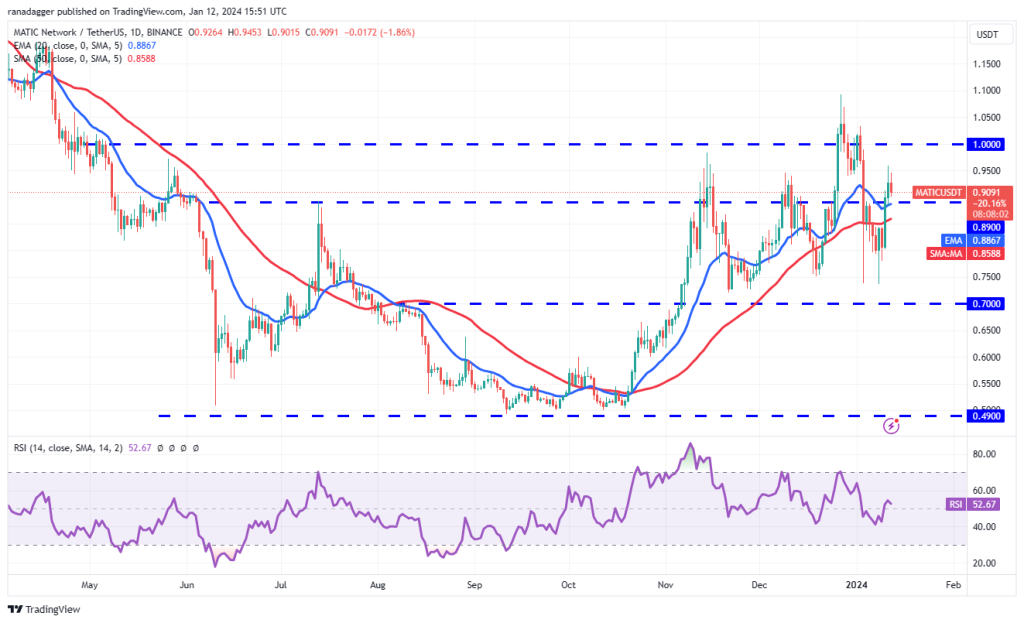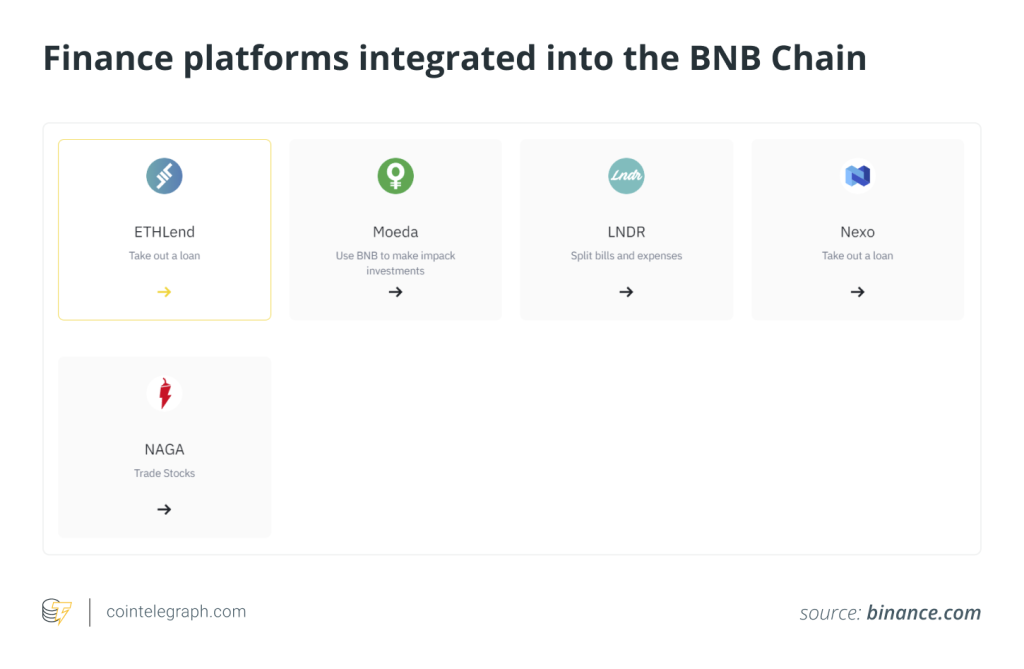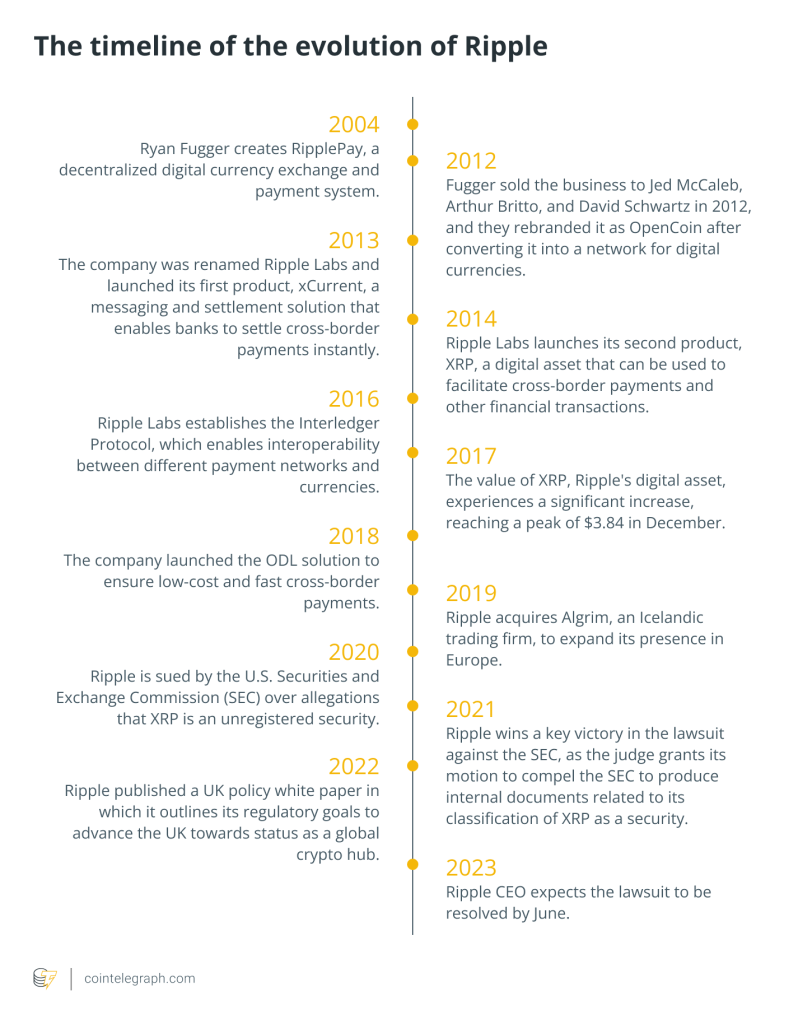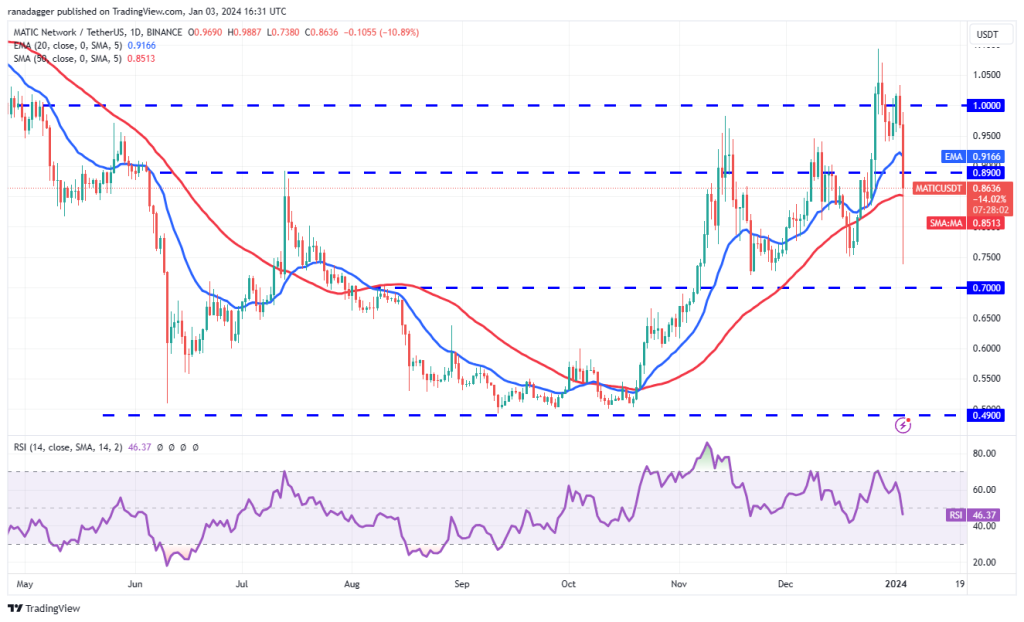Price analysis 1/12: BTC, ETH, BNB, SOL, XRP, ADA, AVAX, DOGE, DOT, MATIC

The Bitcoin ETFs generated strong volumes on Jan. 11, but that did not translate into higher prices in Bitcoin, indicating that the event was largely priced in.

The United States regulator finally green-lighted the Bitcoin (BTC) spot exchange-traded fund applications on Jan. 10, and several ETFs started trading on Jan. 11. The outcome was so extensively discussed that the event did not result in a massive spike or a sharp sell-off, suggesting that the approval was largely priced in.
Even without any bullish tailwind, the Bitcoin ETFs generated enough interest among traders. Data shows that the combined trading volume in the newly launched Bitcoin ETFs touched $4.5 billion on day one of trading.

After an initial correction, Bitcoin may enter a range in the near term as traders wait for the institutional flows into Bitcoin ETFs to begin. However, in the long term, Bitcoin ETFs, along with Bitcoin halving in April 2024, are likely to cause a supply squeeze, boosting prices higher.
What critical support levels may attract buying in Bitcoin and altcoins? Let’s analyze the charts of the top 10 cryptocurrencies to find out.
Bitcoin price analysis
Bitcoin has been volatile in the past few days, as seen from the long tail on Jan. 10 and the long wick on the Jan. 11 candlestick. This suggests buying at lower levels and selling on rallies.

The bears have pulled the price below the breakout level of $44,700, signaling that the markets have rejected the higher levels. The bulls will try to arrest the fall at the 50-day simple moving average ($42,404).
If the price rebounds off the 50-day SMA, the bulls will try to kick the price back above the overhead resistance at $44,700. If they can pull it off, the BTC/USDT pair may climb to $49,000 and then to $52,000.
On the contrary, a break below the 50-day SMA could accelerate selling, and the pair may plunge to $40,000 and eventually to $37,980.
Ether price analysis
Ether (ETH) skyrocketed above the overhead resistance of $2,400 on Jan. 10, signaling the start of the next leg of the uptrend.

The first target on the upside is $2,700, which may tempt short-term traders to book profits. However, if the ETH/USDT does not give up much ground from this level, it will suggest that every minor dip is being purchased. That could improve the prospects of a move to the psychologically important level of $3,000.
The first support on the downside is $2,566. If this level is taken out, the pair may drop to $2,500 and then to the breakout level of $2,400.
BNB price analysis
BNB’s (BNB) pullback stalled at the 20-day EMA ($300) on Jan. 8, indicating that the sentiment remains positive and traders are buying on dips.

The bulls started a recovery on Jan. 10, but they could not maintain the momentum. This suggests that rallies are being sold into. If bears sink and sustain the price below the 20-day EMA, the selling could intensify, and the BNB/USDT pair may plummet to the neckline.
Instead, if the price once again bounces off the 20-day EMA, it will suggest that the bulls remain in control. That will increase the possibility of a rally to $350. If buyers overcome this resistance, the BNB/USDT pair could start its march to $400.
Solana price analysis
Solana (SOL) has been squeezed between the uptrend line and the downtrend line for the past several days.

The flattish 20-day EMA ($97) and the RSI near the midpoint do not give a clear advantage either to the bulls or the bears. If the price sustains below the 20-day EMA, the SOL/USDT pair could dip to the uptrend line. If this support also cracks, the correction may deepen to $67.
On the contrary, the bulls will have to drive and sustain the price above the downtrend line to gain the upper hand. The pair may then ascend to $117 and subsequently to $126.
XRP price analysis
XRP (XRP) clawed back above the breakdown level of $0.57 on Jan. 10, indicating solid buying at lower levels.

Both moving averages have flattened out, and the RSI is just below the midpoint, suggesting that the selling pressure is reducing. The bulls will have to shove and sustain the price above the downtrend line to signal the start of an up move. The XRP/USDT pair may attempt a rally to $0.67 and later to $0.74.
If bears want to prevent the upward move, they will have to quickly yank the price below the strong support at $0.54. If they succeed, it will clear the path for a further decline to $0.50 and eventually to $0.46.
Cardano price analysis
Cardano (ADA) rose above the moving averages on Jan. 10, but the bulls could not maintain the momentum and clear the hurdle at the downtrend line.

The bears are trying to pull the price below the 20-day EMA ($0.56), which may start a downward move toward $0.46. That may keep the ADA/USDT pair between the downtrend line and $0.46.The flattening 20-day EMA and the RSI just above the midpoint do not give a clear advantage either to the bulls or the bears.
This view will be invalidated if the price bounces off the 20-day EMA and pole vaults above the downtrend line. The pair could then retest the overhead resistance at $0.68. If this hurdle is cleared, the pair may rally to $0.90.
Avalanche price analysis
Avalanche (AVAX) turned up from the 50-day SMA ($34.83) on Jan. 10 and rose above the neckline at $38, indicating that the bulls are trying to trap the aggressive bears.

The 20-day EMA ($38.06) is flattening out, and the RSI is near the midpoint, indicating a balance between supply and demand. A close below the 20-day EMA could sink the AVAX/USDT pair to the 50-day SMA and later to $31.
Contrarily, if the price turns up from the current level, it will suggest that the bulls are trying to flip $38 into support. The pair may then climb to $44, where the bears are likely to mount a strong defense.
Related: Spot Bitcoin ETF approved in the US: What to expect next
Dogecoin price analysis
Buyers pushed Dogecoin (DOGE) above the 20-day EMA ($0.09) on Jan. 11, but they could not achieve a close above it. This shows that the bears are viewing the rallies as a selling opportunity.

If the price continues lower, the bears will try to tug the DOGE/USDT pair to the next support at $0.07. Buyers are expected to defend the level with vigor because a failure to do so could sink the pair to $0.06.
On the upside, the bulls will have to drive and sustain the price above the moving averages to indicate that the corrective phase may be over. The pair may then climb to the $0.10 to $0.11 overhead resistance zone.
Polkadot price analysis
Polkadot (DOT) bounced off the 50-day SMA ($7.09) and rose above the overhead resistance of $7.90 on Jan. 10.

The bulls tried to continue the up move on Jan. 11, but the long wick on the candlestick shows selling at higher levels. The bears are trying to pull the price below the 20-day EMA ($7.74). If they do that, the DOT/USDT will form a symmetrical triangle pattern.
Usually, the symmetrical triangle is a continuation pattern, but it behaves as a reversal set up at times. A slide below the support line could start a sharp decline, while a break above the triangle will open the doors for a possible retest of $9.59.
Polygon price analysis
Polygon (MATIC) surged and closed above the moving averages on Jan. 10, indicating aggressive buying by the bulls.

The 20-day EMA ($0.88) has started to turn up, and the RSI is just above the midpoint, signaling a slight advantage to the buyers. If the price bounces off $0.89, the bulls will try to propel the MATIC/USDT pair to $1.
Conversely, if the price turns down and skids below the 20-day EMA, it will suggest a lack of demand at higher levels. That may keep the pair range-bound between $0.70 and $1 for a few more days.






… [Trackback]
[…] Find More Info here to that Topic: x.superex.com/news/bitcoin/2463/ […]
… [Trackback]
[…] Read More on to that Topic: x.superex.com/news/bitcoin/2463/ […]
… [Trackback]
[…] Read More Information here on that Topic: x.superex.com/news/bitcoin/2463/ […]
… [Trackback]
[…] Info to that Topic: x.superex.com/news/bitcoin/2463/ […]
… [Trackback]
[…] There you will find 54476 more Info to that Topic: x.superex.com/news/bitcoin/2463/ […]
… [Trackback]
[…] Read More to that Topic: x.superex.com/news/bitcoin/2463/ […]
… [Trackback]
[…] Info to that Topic: x.superex.com/news/bitcoin/2463/ […]
… [Trackback]
[…] Find More on that Topic: x.superex.com/news/bitcoin/2463/ […]
… [Trackback]
[…] Find More here on that Topic: x.superex.com/news/bitcoin/2463/ […]
… [Trackback]
[…] Info on that Topic: x.superex.com/news/bitcoin/2463/ […]
… [Trackback]
[…] Information on that Topic: x.superex.com/news/bitcoin/2463/ […]
… [Trackback]
[…] Read More on on that Topic: x.superex.com/news/bitcoin/2463/ […]
… [Trackback]
[…] Info on that Topic: x.superex.com/news/bitcoin/2463/ […]
… [Trackback]
[…] Find More Information here on that Topic: x.superex.com/news/bitcoin/2463/ […]
… [Trackback]
[…] Read More Information here on that Topic: x.superex.com/news/bitcoin/2463/ […]
… [Trackback]
[…] Find More on that Topic: x.superex.com/news/bitcoin/2463/ […]
… [Trackback]
[…] Read More to that Topic: x.superex.com/news/bitcoin/2463/ […]
… [Trackback]
[…] Read More on that Topic: x.superex.com/news/bitcoin/2463/ […]
… [Trackback]
[…] Read More to that Topic: x.superex.com/news/bitcoin/2463/ […]